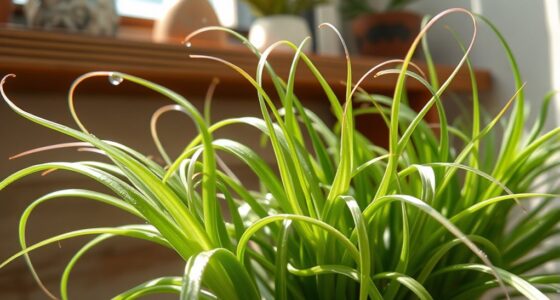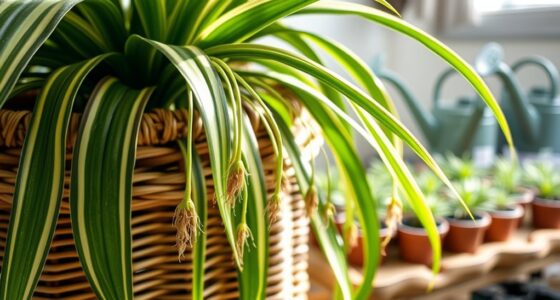To care for your prayer plant and highlight its beautiful maranta patterns, provide bright, indirect light—avoid direct sun which can burn leaves. Keep the soil consistently moist but not soggy, watering when the top inch feels dry, and guarantee proper drainage. Boost humidity with misting or a humidifier, as this supports vibrant foliage and leaf movements. Maintaining stable light and moisture conditions helps your plant thrive and move naturally; there’s much more you can do to perfect its care.
Key Takeaways
- Provide bright, indirect light, such as near a filtered window, to enhance Maranta’s vibrant foliage and natural movement.
- Keep soil consistently moist without waterlogging, watering when the top inch feels dry, using room temperature water.
- Maintain high humidity through misting or humidifiers to support healthy leaves and the plant’s prayer movement.
- Avoid sudden changes in lighting or watering to prevent stress and promote natural leaf-folding behavior.
- Use self-watering pots or monitor soil moisture regularly for optimal watering and plant health.

Have you ever noticed how prayer plants seem to “perform” a nightly dance, folding their leaves upward as if in prayer? This fascinating movement is a natural response to their environment, and understanding how to support this behavior begins with their lighting conditions and watering schedule. Prayer plants thrive in bright, indirect light. Direct sunlight can scorch their delicate leaves, causing the vibrant patterns to fade or develop brown patches. On the other hand, too little light can result in dull foliage and slow growth. The key is to place your prayer plant near a window that filters sunlight, such as behind sheer curtains, ensuring it receives ample, gentle illumination throughout the day. If natural light is limited, you can supplement with fluorescent or LED grow lights, but avoid placing the plant under intense, direct rays for extended periods.
Equally important is maintaining a proper watering schedule. Prayer plants prefer consistently moist soil, but they don’t like to sit in water. Overwatering leads to root rot, while underwatering causes the leaves to wilt and lose their vibrant patterns. To keep your plant happy, water when the top inch of soil feels dry. During the warmer months, this might mean watering once a week, but always adjust based on your home’s humidity and temperature. Use room temperature water to prevent shocking the roots, and ensure excess water can drain freely from the pot. If you’re unsure, check the soil moisture with your finger—if it still feels moist, hold off on watering. The plant’s movement at night is also influenced by light and moisture levels, so keeping consistent conditions helps it perform its nightly leaf-folding routine beautifully.
Additionally, pay attention to the humidity around your prayer plant. It prefers higher humidity levels, which you can achieve by misting the leaves regularly or placing a humidifier nearby. This not only supports its movement but also keeps the foliage healthy and vibrant. Proper watering techniques help prevent stress and promote healthy growth. Remember, fluctuations in lighting or watering can stress the plant, disrupting its natural movements and overall health. Consistency is key: provide filtered light, water appropriately, and maintain humidity to mimic its natural tropical environment.
Frequently Asked Questions
How Often Should I Repot My Prayer Plant?
You should repot your prayer plant every 1 to 2 years to guarantee healthy growth. Keep an eye on its size; if roots are circling the container or it becomes root-bound, it’s time for a larger plant container size. Repotting helps refresh the soil and gives the roots more room to grow, promoting vibrant leaves and overall health. Regular repotting prevents the plant from becoming cramped and stressed.
Can Prayer Plants Tolerate Direct Sunlight?
No, prayer plants can’t tolerate direct sunlight as it can scorch their delicate leaves and harm their vibrant leaf coloration. They thrive in bright, indirect light, which meets their light requirements and keeps their patterns vivid. If you place your plant in harsh sunlight, expect faded or bleached leaves. To keep your prayer plant healthy, provide filtered sunlight or place it near a window with sheer curtains.
What Pests Commonly Attack Prayer Plants?
You should watch out for common pests like spider mites, mealybugs, and aphids attacking your prayer plant. These pests can cause leaves to yellow, curl, or develop sticky residue. To prevent infestations, regularly inspect your plant and keep it healthy with proper watering and humidity. Pest prevention also includes isolating new plants and cleaning leaves gently. If you notice pests, treat your prayer plant promptly with insecticidal soap or neem oil.
How Do I Revive a Wilted Prayer Plant?
To revive a wilted prayer plant, start by checking its watering schedule and soil moisture. If the soil feels dry, give it a thorough, but not overabundant, watering to restore hydration. Guarantee it’s placed in bright, indirect sunlight, and maintain consistent moisture without waterlogging. Adjust your watering frequency based on the plant’s needs, keeping the soil slightly moist to help it perk up and regain its vibrant pattern.
Is It Safe to Keep Prayer Plants Around Pets?
Sure, keep your adorable pets close, but don’t expect them to enjoy munching on your prayer plant. While prayer plants are lovely, they’re actually toxic plants, so pet safety should be your priority. Keep them out of reach or opt for pet-safe plants instead. Your furry friends’ health is worth more than a pretty leaf, so don’t gamble with toxic plants around curious noses and paws.
Conclusion
To keep your prayer plant thriving, you need to water it properly, provide the right light, and maintain consistent humidity. To encourage vibrant leaves and healthy growth, you must pay attention to its needs, adjust your care routine, and enjoy its unique patterns. To bring beauty and serenity to your space, to nurture with patience and love, and to watch your prayer plant flourish—these simple steps will guarantee your plant remains a stunning centerpiece in your home.









